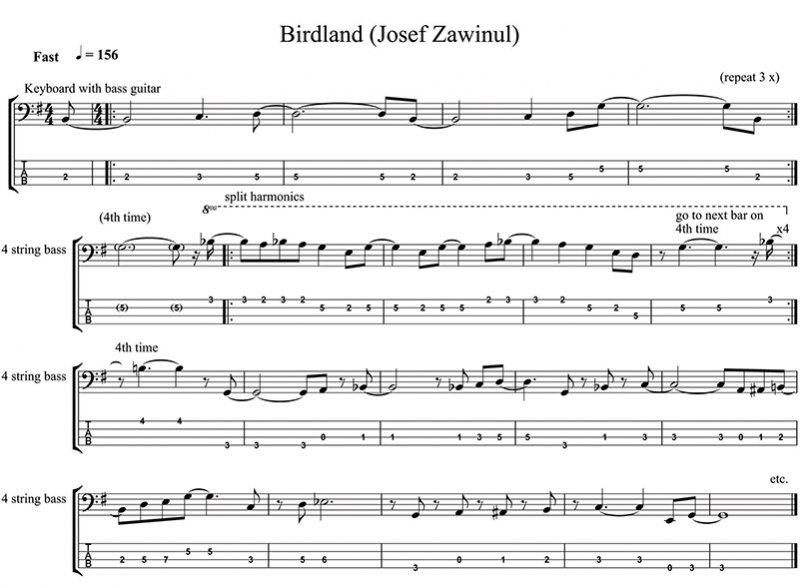Deep Thinking: Weather Report’s Birdland
Deep Thinking: Weather Report’s Birdland
For this issue, I have transcribed the opening bass part on the seminal Weather Report track Birdland from the band’s 1977 album ‘Heavy Weather‘. The transcription features the band’s bassist, the legendary Jaco Pastorius, but the piece was composed by the Weather Report’s keyboard player, Josef Zawinul.
Birdland opens with three 4 bar phrases played with an ARP 2600 (try finding one of those these days!) using a figure one octave below bass guitar with the bass guitar coming. I have written the part an octave higher for four-string bass but it can be played like the recording on a five-string bass.
After the third 4 bar keyboard phrase, the bass guitar comes in with a semiquaver push (the keyboard keeps playing the four-bar phrase under the bass guitar which is why I have written ‘fourth time’ because the bass comes in of the fourth time). The bass plays a 16 bar melody using what is commonly referred to as split harmonics.
I have transcribed this melodic section using the notes as they would be played in a standard fashion but they are an octave higher than written. I saw Pastorius play with his Twins band shortly before his death and he didn’t play this piece. However, it can be performed in two ways. When playing split harmonic melodies, some bassists prefer to put their index finger on the harmonic node point and pluck with their thumb.
I saw Stanley Clarke do it another way and that’s how I’ve always done it. Put your picking hand thumb on the node point and pick with fingers two or three. To get the right harmonic register for Birdland’s melody, the first eight bars have the node point about 5 or 6 cms. beyond your last fret on a standard long scale bass (the melody starts with a high Bb and it might be worth learning the tune where it is written ‘normally’ before you try the split harmonics. The piece is on YouTube).
You need to pick with your thumb and third finger about 6 or 7 cms apart. The tricky part is that your node point must always be exactly the same distance from the fretted note, so your picking hand is always moving as your fretting position changes.
In the second half of the melody, Pastorius moves up an octave by changing the first node point to approximately 13cms beyond the last fret and repeats the previous eight bars. You still need to keep the picking thumb and third finger about 5 or 6 cms apart and move your picking hand as the fretting position changes. This area of the string length has many node points in a similar way to the opposite end of the neck near the nut, so you can have some fun finding how many split (and false) harmonics are in both places.
The entire 16 bar melody ends on a B at fret 4, string 1, before going on to counter the keyboard bass part. This section demonstrates Pastorius’s deft use of syncopation and chromaticism. I’ve ended the transcription just as the bass goes into a G drone section with the Fender Rhodes piano.
You will need a lot of mids and highs in your eq and this piece is a lot easier to play if you grow your picking hand nails a bit more than you might usually. Enjoy experimenting and work out some split harmonic figures of your own.
Dr. Rob Burns is a newly(!) retired Associate Professor in Music at the University of Otago in Dunedin. As a former professional studio bassist in the UK, he performed and recorded with David Gilmour, Pete Townsend, Jerry Donahue, Isaac Hayes, Sam and Dave, James Burton, Ian Paice and Jon Lord, Eric Burdon and members of Abba. He played on the soundtracks on many UK television shows, such as Red Dwarf, Mr. Bean, Blackadder, Not the Nine O’Clock News, and Alas Smith and Jones. Rob is a member of Dunedin band, The Verlaines.

